
Cyprinidae is a family of freshwater fish commonly called the carp or minnow family, including the carps, the true minnows, and their relatives the barbs and barbels, among others. Cyprinidae is the largest and most diverse fish family, and the largest vertebrate animal family overall, with about 3,000 species; only 1,270 of these remain extant, divided into about 200 valid genera. Cyprinids range from about 12 mm in size to the 3 m (9.8 ft) giant barb. By genus and species count, the family makes up more than two-thirds of the ostariophysian order Cypriniformes. The family name is derived from the Greek word kyprînos.

Cod is the common name for the demersal fish genus Gadus, belonging to the family Gadidae. Cod is also used as part of the common name for a number of other fish species, and one species that belongs to genus Gadus is commonly not called cod.

A tuna is a saltwater fish that belongs to the tribe Thunnini, a subgrouping of the Scombridae (mackerel) family. The Thunnini comprise 15 species across five genera, the sizes of which vary greatly, ranging from the bullet tuna up to the Atlantic bluefin tuna, which averages 2 m (6.6 ft) and is believed to live up to 50 years.

Pollock or pollack is the common name used for either of the two species of North Atlantic marine fish in the genus Pollachius. Pollachius pollachius is referred to as pollock in North America, Ireland and the United Kingdom, while Pollachius virens is usually known as saithe or coley in Great Britain and Ireland. Other names for P. pollachius include the Atlantic pollock, European pollock, lieu jaune, and lythe; while P. virens is also known as Boston blue, silver bill, or saithe.

Carcharhiniformes, the ground sharks, are the largest order of sharks, with over 270 species. They include a number of common types, such as catsharks, swellsharks, and the sandbar shark.

The Squaliformes are an order of sharks that includes about 126 species in seven families.

Coryphaena is a genus of marine ray-finned fishes known as the dolphinfishes, and is currently the only known genus in the family Coryphaenidae. The generic name is from Greek κορυφή and -αινα. Species in this genus have compressed heads and single dorsal fins that run the entire length of the fishes' bodies.

Carpet sharks are sharks classified in the order Orectolobiformes. Sometimes the common name "carpet shark" is used interchangeably with "wobbegong", which is the common name of sharks in the family Orectolobidae. Carpet sharks have five gill slits, two spineless dorsal fins, and a small mouth that does not extend past the eyes. Many species have barbels.
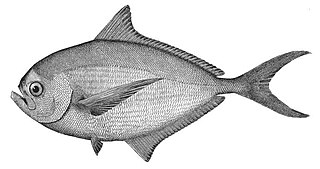
Pomfrets are perciform fish belonging to the family Bramidae. The family currently includes 20 species across seven genera. Several species are important food sources for humans, especially Brama brama in South Asia. The earlier form of the pomfret's name was "pamflet", a word which probably ultimately comes from Portuguese pampo, referring to various fish such as the blue butterfish. The fish meat is white in color.

Sebastes is a genus of marine ray-finned fish belonging to the subfamily Sebastinae part of the family Scorpaenidae, most of which have the common name of rockfish. A few are called ocean perch, sea perch or redfish instead. They are found in the Atlantic and Pacific Oceans.

Sander is a genus of predatory ray-finned fish in the family Percidae, which also includes the perches, ruffes, and darters. They are also known as "pike-perch" because of their resemblance to fish in the unrelated Esocidae (pike) family. They are the only genus in the monotypic tribe Luciopercini, which is one of two tribes in the subfamily Luciopercinae,

Rabbitfishes or spinefoots are perciform fishes in the family Siganidae. The 29 species are in a single genus, Siganus. In some now obsolete classifications, the species having prominent face stripes—colloquially called foxfaces–are in the genus Lo. Other species, such as the masked spinefoot, show a reduced form of the stripe pattern. Rabbitfishes are native to shallow waters in the Indo-Pacific, but S. luridus and S. rivulatus have become established in the eastern Mediterranean via Lessepsian migration. They are commercially important food fish, and can be used in the preparation of dishes such as bagoong.

Notothenioidei is one of 19 suborders of the order Perciformes. The group is found mainly in Antarctic and Subantarctic waters, with some species ranging north to southern Australia and southern South America. Notothenioids constitute approximately 90% of the fish biomass in the continental shelf waters surrounding Antarctica.
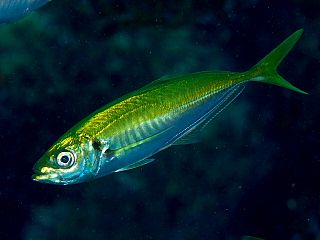
Jack mackerels or saurels are marine fish in the genus Trachurus of the family Carangidae. The name of the genus derives from the Greek words trachys ("rough") and oura ("tail"). Some species, such as T. murphyi, are harvested in purse seine nets, and overfishing has sometimes occurred.
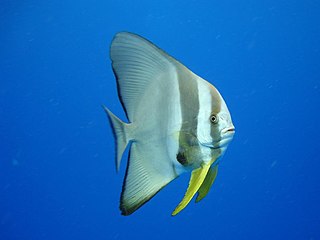
Platax is a genus of Indo-Pacific, reef-associated fish belonging to the family Ephippidae. There are currently five known extant species generally accepted to belong to the genus. They are one of the fish taxa commonly known as "batfish".

The imposter trevally, also known as the imposter jack or white-tongued trevally, is a species of small coastal marine fish in the jack family Carangidae. The imposter trevally is distributed through the tropical waters of Indian and west Pacific oceans, from the Gulf of Oman in the west to Japan and Australia in the east. The species is quite similar to the Malabar trevally, but can be distinguished by its gill raker count, and is identifiable from other species by having a white to pale grey tongue. It is a relatively small species, growing to a maximum recorded length of 30 cm. The imposter trevally inhabits coastal waters of the continental shelf in depths of up to 140 m, often associating with closely related carangid species. It preys on a range of small fish, crustaceans and cephalopods, but little is known of its reproductive biology. The imposter trevally is of minor importance to fisheries throughout its range, taken by hook and line, bottom trawls and several types of artisanal gear.

The Catostomidae are the suckers of the order Cypriniformes, with about 78 species in this family of freshwater fishes. The Catostomidae are almost exclusively native to North America. The only exceptions are Catostomus catostomus, found in both North America and Russia, and Myxocyprinus asiaticus found only in China. In the Ozarks they are a common food fish and a festival is held each year to celebrate them. The bigmouth buffalo, Ictiobus cyprinellus, can reach an age up to 127 years, making it the oldest known freshwater teleost by more than 50 years.
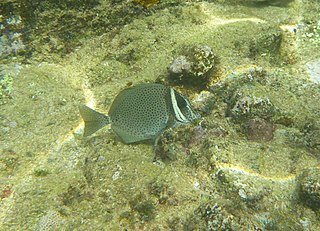
Prionurus biafraensis, the Biafra doctorfish, is a species of marine ray-finned fish belonging to the family Acanthuridae, the surgeonfishes, unicornfishes and tangs. This fish is found in the eastern Atlantic Ocean.
John Ernest "Jack" Randall was an American ichthyologist and a leading authority on coral reef fishes. Randall described over 800 species and authored 11 books and over 900 scientific papers and popular articles. He spent most of his career working in Hawaii. He died in April 2020 at the age of 95.
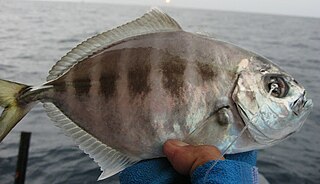
Uraspis uraspis is a species of jack in the family Carangidae. It is found in the Indo-Pacific.






















